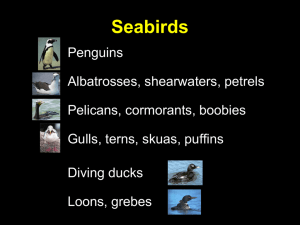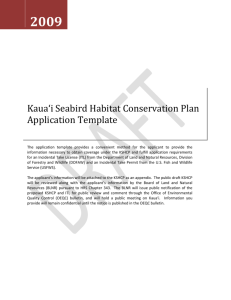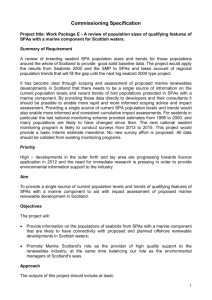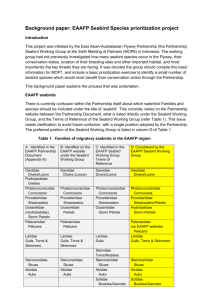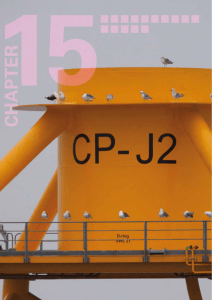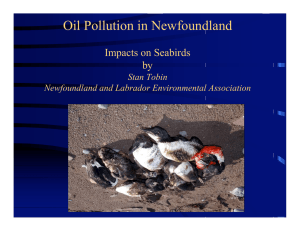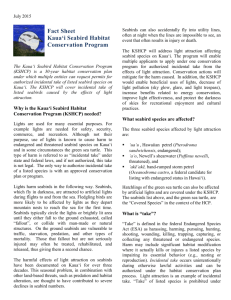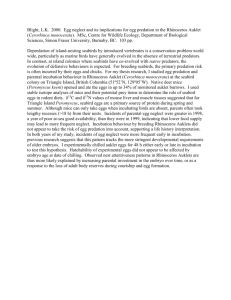Seabird Research and Monitoring Needs in Northwestern México Abstract Eduardo Palacios
advertisement
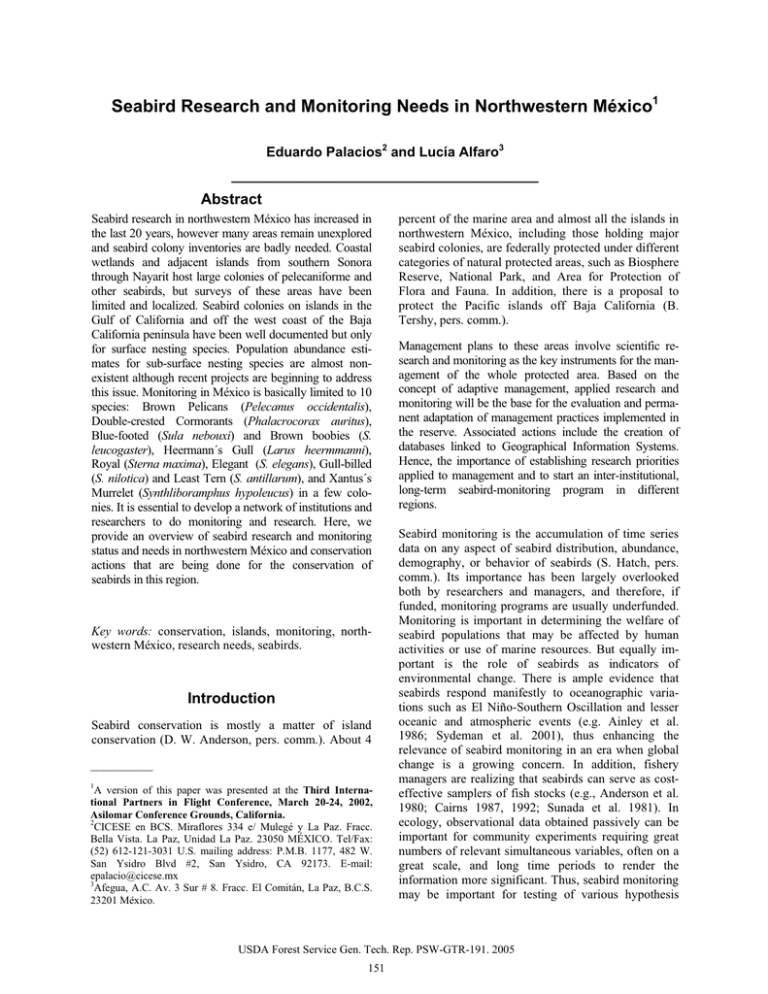
Seabird Research and Monitoring Needs in Northwestern México1 Eduardo Palacios2 and Lucía Alfaro3 ________________________________________ Abstract Seabird research in northwestern México has increased in the last 20 years, however many areas remain unexplored and seabird colony inventories are badly needed. Coastal wetlands and adjacent islands from southern Sonora through Nayarit host large colonies of pelecaniforme and other seabirds, but surveys of these areas have been limited and localized. Seabird colonies on islands in the Gulf of California and off the west coast of the Baja California peninsula have been well documented but only for surface nesting species. Population abundance estimates for sub-surface nesting species are almost nonexistent although recent projects are beginning to address this issue. Monitoring in México is basically limited to 10 species: Brown Pelicans (Pelecanus occidentalis), Double-crested Cormorants (Phalacrocorax auritus), Blue-footed (Sula nebouxi) and Brown boobies (S. leucogaster), Heermann´s Gull (Larus heermmanni), Royal (Sterna maxima), Elegant (S. elegans), Gull-billed (S. nilotica) and Least Tern (S. antillarum), and Xantus´s Murrelet (Synthliboramphus hypoleucus) in a few colonies. It is essential to develop a network of institutions and researchers to do monitoring and research. Here, we provide an overview of seabird research and monitoring status and needs in northwestern México and conservation actions that are being done for the conservation of seabirds in this region. Key words: conservation, islands, monitoring, northwestern México, research needs, seabirds. Introduction Seabird conservation is mostly a matter of island conservation (D. W. Anderson, pers. comm.). About 4 __________ 1 A version of this paper was presented at the Third International Partners in Flight Conference, March 20-24, 2002, Asilomar Conference Grounds, California. 2 CICESE en BCS. Miraflores 334 e/ Mulegé y La Paz. Fracc. Bella Vista. La Paz, Unidad La Paz. 23050 MÉXICO. Tel/Fax: (52) 612-121-3031 U.S. mailing address: P.M.B. 1177, 482 W. San Ysidro Blvd #2, San Ysidro, CA 92173. E-mail: epalacio@cicese.mx 3 Afegua, A.C. Av. 3 Sur # 8. Fracc. El Comitán, La Paz, B.C.S. 23201 México. percent of the marine area and almost all the islands in northwestern México, including those holding major seabird colonies, are federally protected under different categories of natural protected areas, such as Biosphere Reserve, National Park, and Area for Protection of Flora and Fauna. In addition, there is a proposal to protect the Pacific islands off Baja California (B. Tershy, pers. comm.). Management plans to these areas involve scientific research and monitoring as the key instruments for the management of the whole protected area. Based on the concept of adaptive management, applied research and monitoring will be the base for the evaluation and permanent adaptation of management practices implemented in the reserve. Associated actions include the creation of databases linked to Geographical Information Systems. Hence, the importance of establishing research priorities applied to management and to start an inter-institutional, long-term seabird-monitoring program in different regions. Seabird monitoring is the accumulation of time series data on any aspect of seabird distribution, abundance, demography, or behavior of seabirds (S. Hatch, pers. comm.). Its importance has been largely overlooked both by researchers and managers, and therefore, if funded, monitoring programs are usually underfunded. Monitoring is important in determining the welfare of seabird populations that may be affected by human activities or use of marine resources. But equally important is the role of seabirds as indicators of environmental change. There is ample evidence that seabirds respond manifestly to oceanographic variations such as El Niño-Southern Oscillation and lesser oceanic and atmospheric events (e.g. Ainley et al. 1986; Sydeman et al. 2001), thus enhancing the relevance of seabird monitoring in an era when global change is a growing concern. In addition, fishery managers are realizing that seabirds can serve as costeffective samplers of fish stocks (e.g., Anderson et al. 1980; Cairns 1987, 1992; Sunada et al. 1981). In ecology, observational data obtained passively can be important for community experiments requiring great numbers of relevant simultaneous variables, often on a great scale, and long time periods to render the information more significant. Thus, seabird monitoring may be important for testing of various hypothesis USDA Forest Service Gen. Tech. Rep. PSW-GTR-191. 2005 151 Seabird Research and Monitoring – Palacios and Alfaro populations of Black (70 percent) and Least (90 percent) storm-petrels, Blue-footed Booby (40 percent), Heermann´s (90 to 95 percent) and Yellowfooted (100 percent) gulls, Elegant Tern (95 percent), and Craveri´s Murrelet (S. craveri) (90 percent) breed in the region. All these taxa, plus Black-vented Shearwater (Puffinus opisthomelas), and Xantus´s Murrelet are endemic or quasi-endemic to the region (Howell 2001). The region also hosts the world´s largest Brown Pelican and Brown Booby colonies (D. W. Anderson, 1983). At least 40 species of seabirds breed on the islands and coastal wetlands in northwestern México (Everett and Anderson 1991, Howell and Webb 1995). regarding environmental or human causes of population dynamics. The objective of this paper is to review seabird research and monitoring needs in northwestern México (fig. 1). We emphasize the need for long-term breeding seabird monitoring programs in different regions or protected areas to provide management agencies the necessary information for better-informed decision-making. 3 4 1 2 Methods EEZ N In 1998, consigned by the Pacific Seabird Group, we initiated a survey and compilation of past and present effort to monitor Pacific seabirds in México. Through literature review and applying a questionnaire to key seabird researchers in the region we focused on past and present efforts to monitor Pacific seabirds — which species have been monitored, where, what parameters have been measured, and who has done the work? We plan to continue this survey in the future because updated on an annual or more frequent basis, this information will permit a continuing evaluation of where we have been in seabird monitoring, where we would like to go, and what we need to do to get there. Here, we considered a total of 70 seabird projects conducted since 1970 that included some sort of monitoring. In addition, we reviewed a list of more than 200 published and unpublished reports that include potential data on seabirds of northwestern México. 5 Figure 1— The region of northwestern México. It includes the peninsula of Baja California that comprises the states of Baja California (1) and Baja California Sur (2), the mainland states of Sonora (3), Sinaloa (4), and Nayarit (5), and the Economic Exclusive Zone (EEZ), including the Gulf of California and its associated islands. Overview The region of northwestern México includes the peninsula of Baja California, the states of Sonora, Sinaloa, and Nayarit, the Gulf of California, the Economic Exclusive Zone (200 nautical miles, expanded by Isla Guadalupe in the north and by Isla Clarión in the south), and its associated islands (fig. 1). This region comprises an important area for seabirds. Specific information on seabirds distribution and conservation needs in northwestern México has been published in three major summaries: Anderson (1983), Everett and Anderson (1991), and Velarde and Anderson (1994). As important, however, are also two books that cover the region: Wilbur (1987) and Howell and Webb (1995), as well as numerous recently published species accounts (e.g., Carter et al. 1995; Erickson and Howell 2001; Massey and Palacios 1994; Mellink 2001; Molina and Garrett 2001; Palacios and Mellink 1996, 2000; Pitman 1986; Rebón-Gallardo 2000, and others). The major ornithological journal on seabirds from the region has been Western Birds (Western Field Ornithologists). Results Seabird colonies on islands in the Gulf of California and off western Baja California peninsula have been well documented but only for surface nesting species. Population abundance estimates for sub-surface nesting species such as storm petrels and murrelets are very few although recent projects (such as the U.S. Geological Survey [USGS] and Island Conservation and Ecology Group [ICEG] surveys, see below) are addressing this gap of knowledge. Monitoring in México is very modest and systematic seabird monitoring is limited to ten species in few colonies: Brown Pelicans, Double-crested Cormorants, Blue-footed and Brown boobies, Heermann´s Gull, Royal, and Elegant, Gull-billed and Least Tern, and Xantus Murrelet. Some particularly noteworthy remarks regarding the importance of the region to seabirds include the following examples: A large percentage of the world In the last 30 years, more than 100 researchers (77 Mexicans and 33 Americans) have been and/or are USDA Forest Service Gen. Tech. Rep. PSW-GTR-191. 2005 152 Seabird Research and Monitoring – Palacios and Alfaro conducting Pacific seabirds research in México. Based on the responses to the survey and on the literature documentation, 55 species of seabirds have been monitored in México, but the extent of the monitoring effort is still to be determined. We reviewed 70 seabird projects conducted since 1970 and major surveys or research projects prior to this date. The periods of these monitoring efforts are not continuous but depend on funding, permits, weather, researchers, students’ or technicians’ availability. Only 13 of these projects were conducted for three or more years; the remaining were single visits to survey a given location, although other papers or people have additional observations for the same locations for other years. From this accumulation of data, a time-series can be built. Of the 13 projects lasting longer than two years, most (70 percent) have monitoring periods around 6 years or less; only three have run for more than 20 years. The temporal frequency of the projects has been mostly 2 or more times per year of study. The main parameters measured during these projects were population size, reproductive success and phenology, foraging studies, and disturbance monitoring. The main research techniques used to collect the information have been shore surveys, boat surveys, in-colony surveys, aerial surveys (photographic), observations outside of a colony, prey collection, and banding. The most important concentrations of potential contributors to a database on the seabirds of northwestern México occur in California, USA (28), Baja California Sur (17), Baja California (15), and México City (15). Current Seabird Monitoring Programs To our knowledge, the ten major current seabird monitoring programs in the region are the following: 1. Since at least 1964, B. Villa-Ramírez and E. Velarde and students (Universidad Nacional Autónoma de México [UNAM]) have been and are currently protecting and monitoring breeding seabird populations on Isla Rasa, northern Gulf of California. 2. Since 1971, D. W. Anderson and students (University of California-Davis [UC-Davis]) and J. O. Keith (Western Environment and Ecology, Inc.) have been and are currently monitoring seabirds in the Midriff islands of the Gulf of California, and other islands in the Gulf of California and off western Baja California, especially California Brown Pelicans and cormorants. 3. Since 1977, F. Gress and D. W. Anderson (UCDavis) have been and are currently, along with E. Palacios, monitoring California Brown Pelicans and cormorants in the northwestern Baja California islands. 4. Since at least 1980, H. Drummond and students (UNAM) have been and are currently investigating seabird behavior in Isla Isabel, Nayarit. 5. Since 1985, E. Palacios (Centro de Investigatión Científica y de Educación Superior de Ensenada [CICESE]) and E. Amador (Centro de Investigationes Biológicas del Noroeste [CIBNOR]) have been and are currently monitoring seabirds breeding in the Baja California coastal wetlands. 6. Between 1987 and 1999, F. Rebón-Gallardo and students (UNAM) monitored seabird populations on Islas Marietas, Nayarit. 7. Since 1991, E. Mellink and students (CICESE) have been and are currently monitoring breeding seabirds mostly in the northern Gulf of California and some other islands in the whole region, including Sinaloa. 8. Since 1994, B. Tershy, D. Croll, B. Keith, J.A. Sánchez, S. Wolf, and others (ICEG) have been monitoring seabirds and removing exotic mammals in 10 of the islands of the region. Additional removal projects are currently in progress and an island conservation database is available over the internet via the world wide web (http://islandconservation.org). 9. Since 1996 K. C. Molina and K. Garrett started monitoring Gull-billed Terns colonies and other waterbirds breeding in the Cerro Prieto geothermal ponds, Baja California. 10. Since at least 2000, H. Carter and others (USGS) have been and are currently studying Xantus Murrelet populations on islands off the west coast of Baja California, especially on Islas Los Coronados. Discussion Major changes in northwestern México seabird populations have occurred without being quantified. Some examples include the demise of the seabird colonies on Islas San Martin and Todos Santos (Palacios and Mellink 2000), the extinction of the Guadalupe Stormpetrel (Oceanodroma macrodactyla) from Isla Guadalupe (Jehl and Everett 1985), the recent colonization of Islas Guadalupe, Clarión and San Benedicto by the Laysan Albatross (Diomedea immutabilis) (Howell and Webb 1992). It is important to document the timing and location of declines and/or increases of seabird populations to better understand the underlying causes. Although seabird research in northwestern México has increased during the last 20 years, many areas remain unexplored, and seabird-colony catalogs are badly needed for the region. In western North America, seabird colony USDA Forest Service Gen. Tech. Rep. PSW-GTR-191. 2005 153 Seabird Research and Monitoring – Palacios and Alfaro Human Impacts include the effect of human disturbance on seabird colonies and direct effects of egging and by-catch in long-line and gill-nets. catalogues and monitoring programs exist for all of Alaska, Washington, Oregon, California, and Hawaii. The next logical step is México. Also, completion of a colony catalogue for western México will complete the series all the way to Central America. Ecological role in ecosystems. These studies would include determining which species were most appropriate as bioindicators for which questions; and competition with human fisheries (pelagic and coastal fisheries, especially in coastal wetlands). The lack of baseline data makes it impossible to quantify changes in numbers in most seabird species over time. Numerical baseline data are sketchy because early ornithologists reported species' presence and breeding information but seldom numbers (Massey and Palacios 1994). We need to plan and promote seabird monitoring on an international basis and to strive for cooperation of seabird specialists throughout the region. Ideally, a few widespread species should be monitored throughout their ranges in the Pacific, which requires an internationally coordinated effort. Habitat ecology research needs include: research on ocean regime shifts, warming, ENSO (El Niño Southern Oscillation), and so forth; changes in fish communities and influence on seabirds; seabird interaction with aquaculture facilities, including methods to minimize impact to birds; and the role of birds as predators. Habitat planning at local/regional level: identification of essential roosting and nesting habitat required for sustaining seabird populations in a given region of conservation concern (scales from a natural protected area to the northwestern region of México). Monitoring needs that we consider high priority include an inventory of past and present monitoring effort in northwestern México (what species? where? what parameters have been measured, and so forth). Then, we can proceed to selection of species, locations, and parameters to be monitored. Conservation problems and threats faced by seabirds in the region have been discussed elsewhere (see Anderson 1980, Anderson and Keith 1980, Anderson et al. 1989, Everett and Anderson 1991, Howell and Webb 1995, Jehl 1984, Velarde and Anderson 1993, and others), but briefly these include offshore pollution, commercial exploitation of prey on which seabirds feed, incidental take, human disturbance, habitat reduction, and introduced predators at colony sites. Seabird monitoring is most effective when it incorporates planned comparisons. For example, paired observations on surface feeders and divers are often revealing (especially if we have temperature and turbidity to correlate with), as are studies targeting different trophic levels (piscivores vs. planktivores) or species with contrasting foraging areas (inshore vs. oceanic feeders in relationship with temperature and/or turbidity). Monitoring of seabird breeding parameters at colonies needs to be done with simultaneous independent measures of prey abundance. Island and seabird conservation in the region is complex, and all developed conservation planning needs to consider the following aspects: (1) Local, state, and federal governments must ensure the protection of these ecosystems by enforcing the environmental law, using data from academia for informed decisionmaking, and supporting applied research to conservation such as monitoring of indicator species and fisheries resources; (2) conservation of natural habitat must continue being an important approach, but should be followed by completion and implementation of management plans; and (3) cooperative programs between Canadian, United States’, and Mexican wildlife agencies should expand, but solutions to the problems must be site-specific and operational. Research and information needs that we consider of high priority for seabird conservation can be grouped into the following categories: populations and their dynamics, human impacts, ecological role in ecosystems, habitat ecology, and habitat planning. Most of these items were also identified as high priority in the Colonial Waterbird Conservation Plan. Populations and their dynamics. This category should include a catalog and mapping of seabird colonies in the region as well as information on the population status of sensitive species (estimated current and past population sizes to establish recovery goals); the subspecific status of sensitive species; and the wintering ecology of seabirds (mortality factors, at-sea distribution, conservation problems in wintering grounds). This will allow us to estimate trends among breeding and nonbreeding populations (trend analyses) and evaluate the most urgent conservation needs. Acknowledgments This work was partially supported by the USGS through the Pacific Seabird Group (thanks to Scott Hatch). Consejo Nacional de Ciencia y Tecnologia (CONACyT) (Repatriation Program) and CICESE in Baja California Sur provided support to E. P. while working on this paper. USDA Forest Service Gen. Tech. Rep. PSW-GTR-191. 2005 154 Seabird Research and Monitoring – Palacios and Alfaro Everett, W. T. and D.W. Anderson. 1991. Status and conservation of the breeding seabirds on offshore islands of Baja California and the Gulf of California. In: J. Croxall editor. Seabird status and conservation: A supplement. ICBP Technical Publication 11; 115-139. Financial support for E. P. to attend the International Partners in Flight (PIF) Conference in Monterey, California in March 2002 was provided by PIF California through the Point Reyes Bird Observatory. We thank R. Rodríguez for insisting on the submission of this paper. Our collaboration with E. Amador-Silva, D. W. Anderson, F. Gress, J. O. Keith, and E. Mellink has taught us most of what we wrote here. To all of them, our deepest gratitude. Howell, S. N. G. 2001. Regional distribution of the breeding avifauna of the Baja California peninsula. In: R. A. Erickson and S. N. G. Howell, editors. Birds of the Baja California peninsula: Status, distribution, and taxonomy. Monographs in Field Ornithology No. 3; 10-22. Literature Cited Howell, S. N. G. and S. Webb. 1992. Changing status of the Laysan Albatross in México. American. Birds 46: 220223. Ainley, D. G., Carter, H. R., Anderson, D. W., Briggs, K. T., Coulter, M. C., Cruz, F., Cruz, J. B., Valle, C. A., Fefer, S. I., Hatch, S. A., Schreiber, E. A., Schreiber, R. W., and Smith, N. G. 1986. Effects of the 1982-83 El NiñoSouthern Oscillation on Pacific Ocean bird populations. Acta XIX Congressus Internationalis Ornithologica 2: 1747-1773. Anderson, D. W. 1980. Islands, seabirds, and man: Conservation in the Gulf of California. In: P. P. Schaeffer and S. M. Ehlers editors. The birds of México. National Audubon Society; 27-37. Anderson, D. W. 1983. The seabirds. In: T. J. Case and M. L. Cody, editors. Island biogeography in the Sea of Cortez. Los Angeles, CA: University of California Press; Ch. 9. Anderson, D. W. 1988. Dose-response relationship between human disturbance and brown pelican breeding success. Wildlife Society Bulletin 16: 339-345. Anderson, D. W., F. Gress, K. F. Mais, and P. R. Kelly. 1980. Brown pelicans as anchovy stock indicators and their relationships to commercial fishing. California Cooperative Oceanic Fisheries Investigations Report. 21: 54-61. Anderson, D. W. and J. O. Keith. 1980. The human influence on seabird nesting success: Conservation implications. Biological Conservation 18: 65-80. Anderson, D. W., J. O. Keith, G. R. Trapp, F. Gress, and L. A. Moreno. 1989. Introduced small ground predators in California brown pelican colonies. Colonial Waterbirds 12: 98-103. Cairns, D. K. 1987. Seabirds as indicators of marine food supplies. Biological Oceanography 5: 261-271. Cairns, D. K. 1992. Bridging the gap between ornithology and fisheries science: Use of seabird data in stock assessment models. Condor 94: 811-824. Carter, H. R., A. L. Sowls, M. S. Rodway, U. W. Wilson, R. W. Lowe, G. J. McChesney, F. Gress and D. W. Anderson. 1995. Population size, trends, and conservation problems of the Double-crested Cormorants on the Pacific coast of North America. Colonial Waterbirds 18 (Special Publication 1): 189-215. Erickson, R. A., and S. N. G. Howell, editors. 2001. Birds of the Baja California peninsula: Status, distribution, and taxonomy. American Birding Association. Monographs in Field Ornithology No. 3; 264 p. Howell, S. N. G., and S. Webb. 1995. A Guide to the birds of México and Northern Central America. Oxford, UK: Oxford University Press. Jehl, J. R., Jr., 1984. Conservation problems of seabirds in Baja California and the Pacific Northwest. In: J.P. Croxall et al., editors: Status and conservation of the world’s seabirds. ICBP (International Council for Bird Preservation) Technical Publication 2: 41-48. Jehl, J. R., Jr., and W. T. Everett. 1985. History and status of the avifauna of Isla Guadalupe, México. Transactions of the San Diego Natural History Museum 20: 313-336. Massey, B. W. and E. Palacios. 1994. Avifauna of the wetlands of Baja California, México: Current status. In: J. R. Jehl, Jr. and N. K. Johnson editors. A century of avifaunal change in western North America. Studies in Avian Biology No. 16: 45-57. Mellink, E. 2001. History and status of colonies of Heermann’s Gull in México. Waterbirds 24: 188-194. Molina, K. C., and K. L. Garrett. 2001. The breeding birds of the Cerro Prieto geothermal ponds, Mexicali Valley, Baja California. In: R. A. Erickson and S. N. G. Howell editors. Birds of the Baja California peninsula: Status, distribution, and taxonomy. Monographs in Field Ornithology No. 3: 23-28. Palacios, E. and E. Mellink. 1996. Status of the least tern in the Gulf of California. Journal of Field Ornithology 67: 48-58. Palacios, E., and E. Mellink. 2000. Nesting waterbirds on Islas San Martín and Todos Santos, Baja California. Western Birds 31:184-189. Pitman, R. L. 1986. Atlas of seabird distribution and relative abundance in the eastern tropical Pacific. Administration Report LJ-86-02C. National Marine Fisheries Service, U. S. Department of the Interior. Rebón-Gallardo, F. 2000. Distribución, abundancia y conservación de la avifauna de las islas Marietas, Nayarit, México. Anales del Instituto de Biología UNAM, Serie Zoología 71(1): 59-88. Sunada, J. S., L. S. Yamashita, P. R. Kelly, and F. Gress. 1981. The brown pelican as sampling instrument of age group structure in the northern anchovy population. California Cooperative Oceanic Fisheries Investigation Report 22: 65-68. USDA Forest Service Gen. Tech. Rep. PSW-GTR-191. 2005 155 Seabird Research and Monitoring – Palacios and Alfaro Sydeman, W. J., M. M. Hester, J. A. Thayer, F. Gress, P. Martin, and J. Buffa. 2001. Climate change, reproductive performance and diet composition of marine birds in the southern California Current system, 1969-1997. Progress in Oceanography 49: 309-329. Velarde, E., and D. W. Anderson. 1994. Conservation and management of seabird islands in the Gulf of California: Setbacks and successes. In: D. N. Nettleship, J. Burger, and M. Gochfeld, editors. Seabirds on islands: Threats, case studies and action plans. BirdLife Conservation Series No. 1; 229-243. Wilbur, S. R. 1987. Birds of Baja California. Berkeley, CA: University of California Press; 253 p. USDA Forest Service Gen. Tech. Rep. PSW-GTR-191. 2005 156
